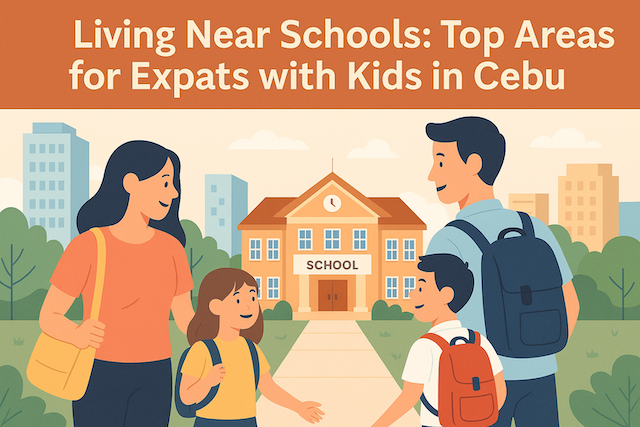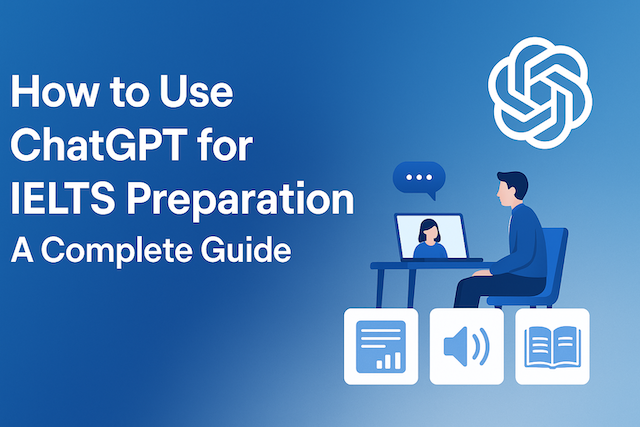Living Near Schools: Top Areas for Expats with Kids in Cebu

Contents
- Living Near Schools: Top Areas for Expats with Kids in Cebu
- Why Proximity to Schools Matters for Expat Families
- Top International and Private Schools in Cebu
- 1. Banilad: Central, Family-Friendly, and School-Heavy
- 2. Talamban and Pit-os: For IB Families and Green Living
- 3. Mandaue (Canduman and Subangdaku): Balanced and Budget-Friendly
- 4. Lahug and Cebu IT Park: For Work-Life-School Convenience
- 5. Talisay City: A Southern Suburban Escape
- Other Notable Mentions
- Choosing the Right Neighborhood: Key Considerations
- Sample Commute Table (Average Travel Time from Each Area to CIS and Singapore School Cebu)
- Tips for a Smooth Relocation with Kids
- Final Thoughts
- Frequently Asked Questions (FAQ)
- 1. What are the best areas in Cebu for expat families with school-age children?
- 2. Which international schools are popular with expat families in Cebu?
- 3. How far is Cebu International School (CIS) from popular residential areas?
- 4. Are there family-friendly gated communities near international schools?
- 5. What is the average cost of renting a home near schools?
- 6. Is living in a condo with children practical in Cebu?
- 7. Do international schools in Cebu offer school bus services?
- 8. How’s the traffic near schools during rush hour?
- 9. Are there any bilingual or multicultural schools in Cebu?
- 10. What kinds of extracurricular activities are available near schools?
- 11. Are medical facilities near school zones reliable?
- 12. Is it easy for children to adapt to life in Cebu?
- 13. What’s the safety situation in neighborhoods near schools?
- 14. Can I walk or bike with my children to school?
- 15. What should I look for when choosing a neighborhood near a school?
Living Near Schools: Top Areas for Expats with Kids in Cebu
Cebu has grown into one of the most livable and expat-friendly regions in the Philippines. For families with children, especially those relocating for work, education is often a top priority when choosing where to live. Thankfully, Cebu is home to several international schools and progressive academies—and more importantly, a variety of neighborhoods and developments that cater to families seeking convenience, security, and quality of life.
In this guide, we explore the best areas in Cebu to live near good schools, covering housing options, accessibility, lifestyle amenities, and family-friendly features.
Why Proximity to Schools Matters for Expat Families
Living close to your child’s school offers a wide range of benefits, including:
-
Reduced commute time for kids and parents
-
More sleep and better academic focus
-
Improved punctuality and attendance
-
Less exposure to traffic and pollution
-
Easier access to school events and emergency pick-ups
For expats juggling work-life balance in a new country, having school just minutes away can significantly ease daily stress.
Top International and Private Schools in Cebu
Before identifying the best residential areas, let’s highlight some of the most reputable international and private schools that expats commonly choose:
| School Name | Location | Curriculum |
|---|---|---|
| Cebu International School (CIS) | Pit-os, Talamban | IB (International Baccalaureate) |
| Woodridge International School | Banilad | International and DepEd |
| Singapore School Cebu | Mandaue | Singaporean & IB |
| British School Cebu (formerly CIE) | Paseo Saturnino, Banilad | British, Cambridge |
| Sacred Heart School – Ateneo de Cebu | Canduman, Mandaue | Filipino-Chinese, Catholic |
| Maria Montessori International School | Gorordo & Banilad | Progressive, US-based |
| PAREF Springdale | Lahug | Classical, Catholic |
1. Banilad: Central, Family-Friendly, and School-Heavy
Why Expats Love It:
Banilad remains a favorite among expat families for its central location, gated subdivisions, and proximity to top schools and malls.
Nearby Schools:
-
Woodridge International School
-
Maria Montessori
-
British School Cebu
-
Bright Academy
Housing Options:
-
North Town Homes (high-end gated)
-
Maria Luisa Estate Park (prestigious village)
-
Banilad Townhouses and Duplexes
-
Condo units along Gov. Cuenco Avenue
Advantages:
-
Close to schools and Ayala Center Cebu
-
Quiet subdivisions, large homes, gardens
-
Easy access to hospitals like Cebu Doctors’ and Perpetual Succour
Challenges:
-
Traffic along Banilad-Talamban corridor during school hours
2. Talamban and Pit-os: For IB Families and Green Living
Why It’s Ideal:
This area is home to the Cebu International School, the only fully-accredited IB World School in the Visayas, drawing families from across the world.
Nearby Schools:
-
Cebu International School
-
Ateneo de Cebu (in nearby Canduman)
-
Rosemont Hills Montessori
Housing Options:
-
Pristina North (premium gated community)
-
Mahogany Grove (mid-range)
-
Villas in Ma. Luisa (Talamban side)
Advantages:
-
Tranquil, green, and suburban
-
Larger lots and homes for growing families
-
Lower cost per square meter vs. city center
Challenges:
-
Distance from Cebu IT Park or Lapu-Lapu workplaces (~30–45 mins)
-
Limited nightlife or commercial activity
3. Mandaue (Canduman and Subangdaku): Balanced and Budget-Friendly
Why Consider Mandaue:
Mandaue, particularly Canduman, is strategically located between Cebu City and the airport, and is close to several good schools.
Nearby Schools:
-
Sacred Heart School – Ateneo de Cebu
-
Singapore School Cebu
-
San Isidro Catholic School
Housing Options:
-
Mid-range subdivisions (e.g., Fuente Canons, Brookfield)
-
Budget-friendly townhouses
-
Condos along Hernan Cortes
Advantages:
-
Less expensive than Banilad or Lahug
-
Growing number of supermarkets, cafés, and gyms
-
Good access to both work hubs and school zones
Challenges:
-
Pockets of traffic in Subangdaku
-
Some areas flood during strong rain
4. Lahug and Cebu IT Park: For Work-Life-School Convenience
Why It’s Popular:
Lahug is near Cebu IT Park—Cebu’s business and BPO district—making it attractive for expats working in tech, startups, or remote jobs.
Nearby Schools:
-
PAREF Springdale
-
Maria Montessori International (Gorordo)
-
Asian College of Technology
Housing Options:
-
Condos in IT Park (e.g., Avida Towers, Calyx)
-
Homes in Beverly Hills Subdivision
-
Small townhouses and apartment buildings
Advantages:
-
Walkability to offices, cafes, and co-working spaces
-
Ideal for young families or digital nomads with kids
-
Access to Ayala Mall and food parks
Challenges:
-
Smaller living spaces in condos
-
Less green space and higher noise levels
5. Talisay City: A Southern Suburban Escape
Why It’s a Hidden Gem:
Talisay offers lower housing costs, beach access, and a growing list of private schools—perfect for families willing to commute a bit.
Nearby Schools:
-
Don Bosco Technology Center
-
Sisters of Mary Boystown
-
Sacred Heart School (South Campus)
-
ACT South Campus
Housing Options:
-
Camella Homes (gated community)
-
Azienda (Italian-inspired hillside living)
-
South Glendale (upscale subdivision)
Advantages:
-
Scenic, coastal setting
-
Ideal for weekend getaways without leaving home
-
Real estate prices 20–30% lower than Cebu City
Challenges:
-
Commute to top-tier international schools takes 30–60 mins
-
Fewer English-speaking expat neighbors
Other Notable Mentions
Lapu-Lapu City (Mactan)
-
Best for families working near Mactan Export Zone or the airport.
-
Schools: St. Alphonsus Catholic School, Infant Jesus Academy, Singapore School Cebu (satellite)
Guadalupe
-
Close to Cebu City proper and hospitals.
-
Schools: Guadalupe Elementary, Southcrest School (progressive)
Choosing the Right Neighborhood: Key Considerations
When selecting where to live near schools, expat families should ask:
1. How close is the school to your work?
A short commute for your child might mean a longer one for you. Find a location that balances both.
2. Is transportation safe and reliable?
Some schools offer school buses. If not, living within 10–15 minutes’ drive or walk is ideal.
3. What is the housing style and cost?
Do you prefer gated subdivisions, condo living, or townhouses? Match your preference with your budget.
4. What’s the environment like?
For children, being close to parks, quiet roads, and play spaces makes a huge difference.
Sample Commute Table (Average Travel Time from Each Area to CIS and Singapore School Cebu)
| Area | CIS (Talamban) | Singapore School (Mandaue) |
|---|---|---|
| Banilad | 15–20 min | 20–25 min |
| Talamban | 5–10 min | 25–35 min |
| Mandaue (Canduman) | 15–20 min | 5–10 min |
| Lahug | 25–30 min | 20–25 min |
| Talisay | 35–50 min | 40–60 min |
Tips for a Smooth Relocation with Kids
-
Visit schools and neighborhoods beforehand to get a feel of the commute and surroundings.
-
Ask about after-school activities—some areas offer dance, sports, and robotics nearby.
-
Join expat parent communities on Facebook for real-time advice.
-
Use real estate agents familiar with school zones to narrow down listings.
-
Look into dual-language tutors or daycare centers, especially for younger children adjusting to a new culture.
Final Thoughts
Living near your child’s school in Cebu can significantly improve your family’s quality of life. With several international and private schools spread across different neighborhoods, the key is to choose a location that balances access to education, housing comfort, and daily convenience.
Top Picks Summary:
-
Banilad: Best for established expat families and convenience
-
Talamban/Pit-os: Best for IB students and nature-lovers
-
Mandaue: Best balance of cost, schools, and location
-
Lahug/IT Park: Best for work proximity and small families
-
Talisay: Best for space, budget, and beach lifestyle
Whether you’re staying short-term or settling down long-term, Cebu offers dynamic options for families who prioritize education and a well-balanced lifestyle.
Frequently Asked Questions (FAQ)
1. What are the best areas in Cebu for expat families with school-age children?
Some of the top areas for expat families include Banilad, Talamban, Mandaue (Canduman), Lahug/IT Park, and Talisay. These locations offer a good balance of proximity to international schools, safe housing, and access to amenities like malls, hospitals, and parks.
2. Which international schools are popular with expat families in Cebu?
The most popular international schools include Cebu International School (CIS), Singapore School Cebu, Woodridge International School, and British School Cebu. Each offers globally recognized curricula like IB or Cambridge, and they attract students from diverse nationalities.
3. How far is Cebu International School (CIS) from popular residential areas?
CIS is located in Pit-os, Talamban. It’s about 10 minutes from Ma. Luisa Estate Park and Pristina North, 20–30 minutes from Banilad, and 35–50 minutes from Lahug or Talisay, depending on traffic conditions.
4. Are there family-friendly gated communities near international schools?
Yes, gated communities like North Town Homes, Maria Luisa Estate Park, Pristina North, and South Glendale are excellent for families. They offer 24/7 security, playgrounds, and recreational spaces, making them ideal for children.
5. What is the average cost of renting a home near schools?
Rental prices vary depending on the area and house size. In Banilad or Pristina North, 3-bedroom houses may cost ₱60,000 to ₱150,000/month. Condos in IT Park start at around ₱25,000 for a 1-bedroom. In Talisay or Mandaue, townhouses can rent for as low as ₱30,000/month.
6. Is living in a condo with children practical in Cebu?
Yes, especially in areas like Lahug or Banilad where many condos offer family-friendly amenities like pools, gardens, and play areas. However, families with more than one child often prefer gated subdivisions for more space and privacy.
7. Do international schools in Cebu offer school bus services?
Most major schools like CIS and Singapore School Cebu offer school transport services within Cebu City, Mandaue, and Lapu-Lapu. However, it’s still best to live within 10–15 km to reduce commute time and allow flexibility in emergencies or after-school programs.
8. How’s the traffic near schools during rush hour?
Traffic can be heavy during weekday mornings (6:30–8:30 AM) and afternoon dismissals (3:00–5:00 PM), especially in Banilad-Talamban and Subangdaku. Living within walking distance of school or along back roads can reduce commute stress.
9. Are there any bilingual or multicultural schools in Cebu?
Yes. Some schools like Singapore School Cebu and Sacred Heart School – Ateneo de Cebu offer bilingual or multicultural environments. Others integrate foreign students via ESL programs and cultural diversity clubs.
10. What kinds of extracurricular activities are available near schools?
Activities range from music and dance classes, robotics, taekwondo, swimming, soccer, and visual arts. Many schools offer these on campus or through nearby centers like Bright Academy or Cebu Country Club. Banilad and Talamban areas have the most enrichment options.
11. Are medical facilities near school zones reliable?
Absolutely. Cebu Doctors Hospital, Chong Hua Hospital, and UCMed are within 15–30 minutes of most expat communities. Smaller clinics are available within subdivisions and commercial areas like Banilad and Lahug.
12. Is it easy for children to adapt to life in Cebu?
Most children adjust quickly, especially those enrolled in international schools where English is the medium of instruction. Many expat families report that their children thrive due to the warm Filipino hospitality and active school communities.
13. What’s the safety situation in neighborhoods near schools?
Areas like Maria Luisa Estate Park, Pristina North, North Town Homes, and South Glendale are considered very safe with 24/7 security. Most condos also have guards, CCTV, and controlled access. It’s advisable to avoid poorly lit or flood-prone areas when choosing a home.
14. Can I walk or bike with my children to school?
In subdivisions like Pristina North and parts of Banilad, walking or biking to nearby schools is possible due to internal roads and sidewalks. However, main roads like Gov. Cuenco or Hernan Cortes can be busy, so caution is advised.
15. What should I look for when choosing a neighborhood near a school?
Consider proximity to school, traffic flow, housing type, security, access to healthcare, noise level, and family amenities like playgrounds. It’s also useful to talk to other expat families and visit the area during school hours to observe the daily routine.




